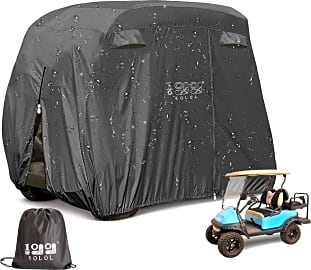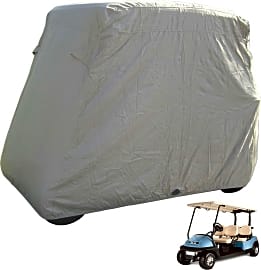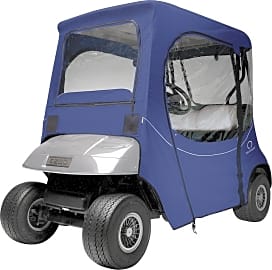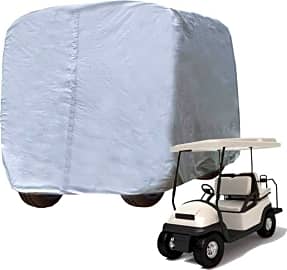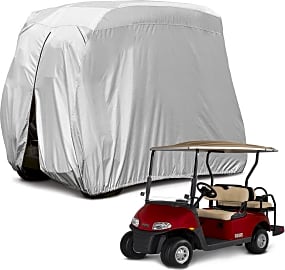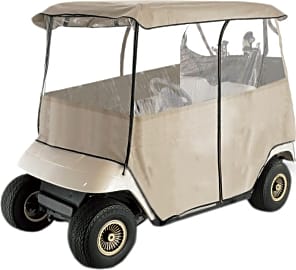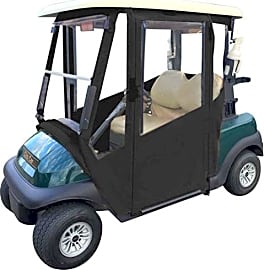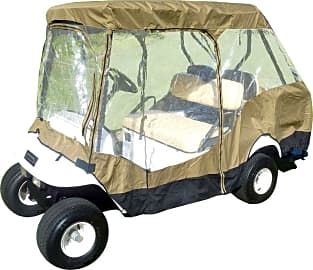The 10 Best Golf Cart Covers

This wiki has been updated 37 times since it was first published in December of 2016. Many of these golf cart covers will help protect your mini vehicle from the elements whenever it's not being used, while others provide protection for you, your passengers, and all of your gear when it starts to rain in the middle of a round. These options vary widely in price and style, from inexpensive, utilitarian choices to stylish selections you'll want to show off. When users buy our independently chosen editorial picks, we may earn commissions to help fund the Wiki.
Editor's Notes
November 11, 2020:
This update resulted in the removal of two products, the Doorworks Enclosures Universal, and the Doorworks Enclosures Portable. Both of these products had received too many reports of durability and fit issues for us to keep them on our list.
We added two new entries, the Kayme Outdoor and the 10L0L Sunproof. These are both moderately-priced models, and are designed to be placed over the cart when not in use, as opposed to transparent models that can be used while driving. These are also both very lightweight, and should be easy for a single person to quickly apply themselves. Something nice about these basic covers is -- even though they're not much to look at -- that they can be easily stored away in a storage bag. Other, fancier, models are a bit more of a hassle to take apart and put away.
If you're interested in a cover for your cart, you might also appreciate a golf cart seat cover. Just like the covers listed above, seat covers are a great way to both extend the life of your cart, as well as add some personal style.
If you live in a cooler climate, but still want to hit the links regularly, one of these golf cart heaters might be a good idea. Some use a small propane tank for fuel, while others hook up directly to your cart's battery.
October 05, 2019:
When it comes to on-the-course protection for you and your golf cart bag, we still think the Classic Accessories Fairway FadeSafe and the Doorworks Enclosures Portable are fine options. They don't add any difficulty to entering and exiting the cart, and they boast sleek, handsome styling. Both fit well, but the Doorworks model is perhaps just a touch too snug, since the tightness can make the zippers feel a touch finicky. For those who are in the market for something even more luxurious, we added the Doorworks Enclosures Hinged; the doors remove in a flash for those hot days when you need more air, but close securely against wind and rain when needed.
As for options designed more for storage, we like the CoverMates Elite, but we added the Explore Land 600D, too. It's incredibly similar to the former, but it costs quite a bit less, making it a strong option for anyone counting their pennies.
Special Honors
ExactFit by Greenline When nothing less than the perfect fabric and color will do, you may wish to consider ExactFit by Greenline. Offered in Sunflair and Sunbrella fabrics, these high-quality covers are made to order and stitched to last for the long haul. A number of accessories are available, as well. nationalgolfcartcovers.com
A Brief History Of Golf Carts
However, his plan backfired after he bought one of the carts, as it turned out they weren't much use on a golf course.
At some point in time, a golfer looked around while he took a leisurely stroll on a lush, green course, and he thought to himself, "You know, I could probably be working even less than this."
That man was JK Wadley of Texarkana, Texas. Wadley spied senior citizens using three-wheeled electric carts to get around grocery stores, and he instantly realized that he'd been a sucker for walking from hole to hole all those Saturdays on the links.
However, his plan backfired after he bought one of the carts, as it turned out they weren't much use on a golf course. That meant he'd have to do some actual work customizing his own golf cart.
In 1932, his custom-made cart debuted, but it wasn't popular with most duffers. The people who did cotton to it, however, were those with disabilities that limited their ability to move from tee to tee. After about 20 years, though, more and more players began to see the benefit in having a cart.
Merle Williams, an inventor from Long Beach, California, began to tinker with his own model in the 1950s. Williams already had some experience with electric vehicles, having experimented with them during gas rationing in WWII. His Marketeer Company released their first cart in 1951.
Unlike Wadley's machine, Williams's prototype enjoyed almost instant success. However, that meant that competition cropped up overnight, and by the end of the decade multiple manufacturers (including Harley-Davidson) were trying to get in on the action.
All of the carts being made at this time were designed to be sold to individual owners, and they were exorbitantly expensive. Clubs began to take note of the revenue possibilities they represented, though, and they began buying them with the intent of renting them to everyday players.
Gas-powered carts took the golf world by storm in the 1970s, and soon retirement homes and gated communities began to purchase them as a means of getting across the property quickly and easily. Around this time, manufacturers began to abandon three-wheeled models in favor of the now-traditional four-wheel variety.
The basic design has stayed the same since then, but modern carts are far more durable and powerful than their ancestors, not to mention faster. However, the best thing about golf carts is something that hasn't changed since their inception: the fact that they won't judge your swing.
Benefits Of Using A Golf Cart
Since walking the course is about the only exercise you get during 18 holes, it may seem counter-intuitive to suggest that using a cart might be a better idea. However, there are some compelling reasons to consider riding instead of hoofing it.
It's better to drive yourself to the next tee and stay in the shade than to have the paramedics drive you to the emergency room.
By saving your energy, you'll stand a better chance of shooting a lower score, as you'll be fresher at each hole. This is especially true if you have a heavy golf bag (and they're all heavy).
Speaking of which, if you have any sort of injury — but especially a bad back — it's smarter to play it safe than risk exacerbating your pain. After all, if you get hurt, you can't play golf, and that's the worst tragedy we can think of.
Carts are a must if you live in an extremely hot environment and want to play in the summer. As Shakespeare probably once wrote, "Heat stroke is no joke," so don't take any chances when the mercury rises. It's better to drive yourself to the next tee and stay in the shade than to have the paramedics drive you to the emergency room.
The most important reason to use a cart, of course, is because they allow you to carry more gear...and that means you get to buy more gear. Everyone's a winner!
Just How Safe Are They, Really?
Golf carts seem like they're incredibly safe, right? After all, you're only going about 15 mph, so how bad could you hurt yourself?
As it turns out, pretty bad, especially if you're a kid. The problem is that most everybody thinks they're harmless, and so they drive recklessly and fail to observe proper safety protocols.
If you obey common-sense safety rules and pay attention, you should be totally fine.
That's especially true for people who take them out on roads. You may feel secure, since you've got a roof over your head, but if you get hit by a car, the cart will only offer about as much protection as a bicycle. There's absolutely no crash safety systems installed, and usually not even a seat belt, so if you rear-end someone at high speeds, the steering column can go right through your sternum like you're a cast member of Alien.
However, the most likely cause of golf cart-related injury involves falls. This can be more likely if you're drinking, of course, but also if you forget to engage the brake or pay attention to the surrounding terrain. Be very careful at all times, but especially when getting in and out of the vehicle.
Besides children, the people most likely to be injured in a golf cart are the people you'd likely expect: seniors older than 80, and males younger than 20. That underscores a basic safety protocol: only let someone drive if you'd feel comfortable with them behind the wheel of an actual car. And with the teens, don't hesitate to report them for horsing around.
None of this means that you should be scared of carts, though. If you obey common-sense safety rules and pay attention, you should be totally fine.
And if you're ever in a situation where the cart's out of control and you have to hit someone, aim for that lousy scratch golfer that makes everyone look bad.



